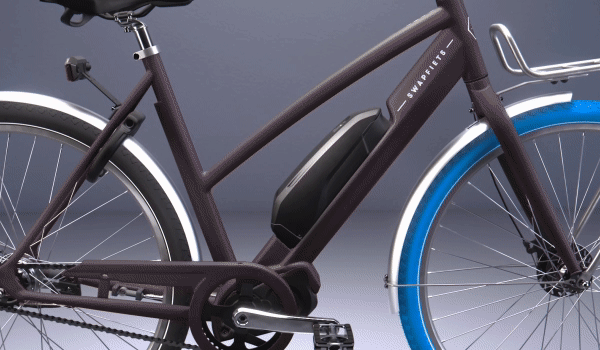With this one-pager, we invite you to join us on our journey to achieve this remarkable goal. You’ll learn more about our ambition, the process and steps we’re taking to get there.
The parts will be assessed with the use of the R-strategies. R-strategies are the 7 different ways to achieve circularity with a product. When we take a look at parts alongside the R-strategies, we want to include the inflow and outflow of the used materials, as well as the life cycle of the bicycle parts.
3. Recycling parts at the end of their technical life (in mono-material waste streams), with the aim to realise net-zero general waste.
Due to our unique business model (product as a service), we are in search of parts with the lowest TCO (total cost of ownership) possible. For this reason, parts with a longer life expectancy are worth more. For instance, a five euro part with a life expectancy of one year is more costly (and therefore more undesirable) than a ten euro part with a life expectancy of three years.
(Purchase cost (production) + life cycle cost (maintenance/service cost/storage) + disposal cost (service/storage)) / life expectancy (user count)
As well as parts being circular, we want to show to members (and the rest of the world!) that we’re a responsible brand - by giving our bike a ‘green’ look, as well as communicating our sustainability initiatives and ethos.
In short, we need solutions in bicycle parts to reach our ambitious goal of a 100% circular in 2025. These are the principles we need to keep in mind:
In the following section, you can learn more about a recent project we’ve undertaken for a circular Swapfiets saddle concept study.
As a company, we often take part in life cycle analysis (LCA) of Swapfiets products. When conducting LCAs, we take a look at the sustainability of certain parts and how much total environmental impact they produce in their life cycle.
In one instance, we found that our saddle parts score poorly in these LCAs. So, in true Swapfiets fashion, we launched a project to identify just what it takes to improve the circularity potential for this element.
Throughout the project we used the R-strategy as a base to achieve circularity on different levels in the total life-cycle. Of course, we also needed to ensure that the saddle design fit our product as a service business strategy.
For us, this means a saddle that is easy to maintain for the mechanics, and is comfortable from a cost and physical point of view, for a Swapfiets member.
There are several things preventing us from achieving circularity with the current saddles on our bikes;
1. Mixed materials that are hard to seperate. Due to this, a clean outflow of materials and an efficient recycle process is not possible.
2. Non renewable/recycled materials. Some parts of these saddles aren’t made with materials that can be made from or disposed of in a circular way.
3. Disassembly is very hard, or sometimes not possible at all. This results in low ambition to do so, resulting in wasted parts. As these parts are relatively cheap to purchase, throwing them away is a quicker (and therefore cheaper) option than repairing.
- The saddle is built on a slightly more expensive frame, but is made to last longer. This, combined with an affordable production method and easily replaceable padding makes it more cost efficient in the long run.
- The frame is made from bamboo, which is highly renewable. This natural material also looks sustainable - improving perception and streetcred regarding sustainable production methods.
- All parts of the saddle are made from different materials that can be separated from each other quicker. Due to this, we can ensure clean outflow of different materials, thus enhancing the recycling process.
About Swapfiets
Over Swapfiets
Swapfiets is 's werelds eerste ‘bike as a service’ bedrijf met een circulair businessmodel. Opgericht in 2014 in Nederland, groeide de scale-up snel uit tot een van de meest toonaangevende leveranciers van micromobiliteit in Europa, met inmiddels meer dan 270.000 leden in Nederland, Duitsland, België, Denemarken, Frankrijk, Spanje en het Verenigd Koninkrijk. Swapfiets streeft naar meer leefbare Europese steden, een 100% circulaire productlijn en wil in 2025 klimaatneutraal zijn. In oktober 2022 trad Swapfiets officieel toe tot de B Corp gemeenschap om hun missie te verstevigen.
Het concept van Swapfiets is vrij eenvoudig: voor een vast bedrag per maand hebben Swapfiets-leden altijd een werkende fiets. En zijn er onverhoopt problemen, dan wordt de fiets binnen 10 minuten in de winkel gerepareerd of direct vervangen zonder extra kosten. Swapfiets is in Nederland beschikbaar in meer dan 50 plaatsen. www.swapfiets.nl
Contact details
Related topics
Related news
We Did It Again: Our 2022 Sustainability Report.
We are a purpose driven business, with the goal to lead the movement to more liveable cities. In this sustainability report, we’re updating you on the progress we’ve made to get there – including t...
Pedal Your Way to a Healthier Mind
This Mental Health Awareness Month, discover the multiple benefits of cycling for your mental health
Own the City, Not the Bike
You don't have to own everything: discover our fresh-off-the-press campaign here
Through raindrops and snowflakes: 5 reasons why cycling year round does wonders for your health
We get it: when the rain hits and temperatures drop, the outside world suddenly seems way less inviting. It’s the season of hibernating with pumpkin spice lattes and Netflix marathons. But guess wh...
Easy, breezy, e-Bike
We might be biased, but E-bikes are so good. What is better than arriving at your destination? Easy. Arriving at your destination faster, easier and less sweaty! Luckily, we have what it takes to m...


![afbeelding One-Pager[1242].png](https://d21buns5ku92am.cloudfront.net/69121/images/407381-afbeelding%20One-Pager%5B1242%5D-9256fd-original-1637055423.png)
![Afbeelding Case study[1241].png](https://d21buns5ku92am.cloudfront.net/69121/images/407382-Afbeelding%20Case%20study%5B1241%5D-7666e2-original-1637056132.png)